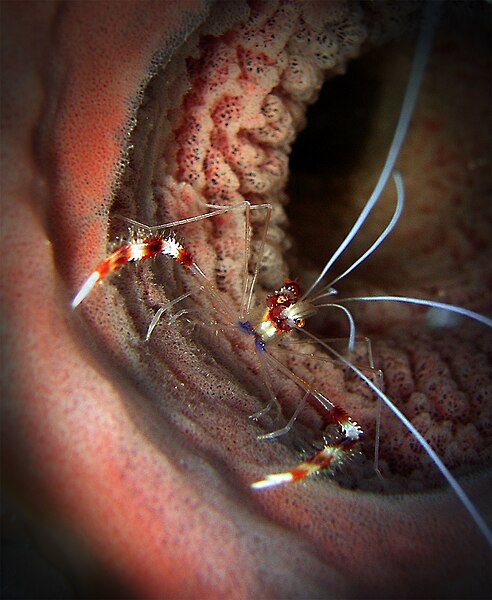 Reef keepers know that the hobby goes through phases in regards to “hot” species on the market. Over the past few years we’ve seen trends in acros, montis, polyps and acans, just to name a few. Reefers can’t seem to get enough…crazy colors, one-of-a kind patterns, endemic color variants. The next big thing for reef enthusiasts may not be a coral, but and anemone – Stichodactyla tapesum, the miniature carpet anemone.
Reef keepers know that the hobby goes through phases in regards to “hot” species on the market. Over the past few years we’ve seen trends in acros, montis, polyps and acans, just to name a few. Reefers can’t seem to get enough…crazy colors, one-of-a kind patterns, endemic color variants. The next big thing for reef enthusiasts may not be a coral, but and anemone – Stichodactyla tapesum, the miniature carpet anemone.
Affectionately referred to as “Maxi Minis” these little guys are related to the much larger true carpet anemones that have been popular for decades. Maxi-mini carpet anemones have recently grown in popularity. Unlike true carpets that can grow to a massive diameter (more than 18 inches across), they only reach a size of about 4-6 inches in diameter. The are found in the rich tropical waters from east coast of Africa across the Indo-Pacific to the Great Barrier Reef and southern Japan. They occur in a wide variety of vivid patterns, and specimens of every color of the rainbow can be seen in a single colony. The appeal is easy to see when you witness their beauty and diversity in person.
Besides the general care of these anemones, not much is known about them. They are hardy and adaptable, easily acclimating to new aquariums. They require good lighting, such as T-5 or LEDs and decent water flow. Actinic or lunar lighting will enhance their appearance, causing some colors to fluoresce. The more they are fed, the faster they will grow and the better color they will have…we recommend feeding at least three times a week. These little anemones are easy to propogate, and will probably split if given good environmental conditions.
 You can put multiple maxi-minis in a single tank, making for a fantastic color display. I have not put them in with any corals, but I have read that others have placed them in stocked coral tanks with no problems. Their sting is rather strong, however, and we have not seen clowns approch these anemones as hosts. They are serving as hosts to anemone shrimp and crabs in our holding tanks though! Anemones usually move around the tank until they find a place that they like. The few maxi-minis that we have stayed in one spot for a majority of the time they have been here, and they seem to prefer a hard surface whether rock or glass to attach to. That’s all for now…but, keep an eye out for these eye catching anemones the next time you’re here. They may be your next obsession.
You can put multiple maxi-minis in a single tank, making for a fantastic color display. I have not put them in with any corals, but I have read that others have placed them in stocked coral tanks with no problems. Their sting is rather strong, however, and we have not seen clowns approch these anemones as hosts. They are serving as hosts to anemone shrimp and crabs in our holding tanks though! Anemones usually move around the tank until they find a place that they like. The few maxi-minis that we have stayed in one spot for a majority of the time they have been here, and they seem to prefer a hard surface whether rock or glass to attach to. That’s all for now…but, keep an eye out for these eye catching anemones the next time you’re here. They may be your next obsession.
Thanks,
Sam
 With the wide range of body shapes and colors, it is hard to believe that all of the fish we call “goldfish” come from the same ancestor, a rather dull, silver/brown carp known as Carassius auratus. Almost two thousand years ago, Asian fisherman raised these fish in ponds for food, and soon the natural orange and yellow mutations of these fish caught the eye of Chinese royalty. Over time, the fish that we know as “goldfish” were selectively bred for specific traits and colors which would eventually become the varieties we see in fish stores today. Let me introduce you to some of the most popular “breeds” that have become aquarium mainstays over the past few hundred years.
With the wide range of body shapes and colors, it is hard to believe that all of the fish we call “goldfish” come from the same ancestor, a rather dull, silver/brown carp known as Carassius auratus. Almost two thousand years ago, Asian fisherman raised these fish in ponds for food, and soon the natural orange and yellow mutations of these fish caught the eye of Chinese royalty. Over time, the fish that we know as “goldfish” were selectively bred for specific traits and colors which would eventually become the varieties we see in fish stores today. Let me introduce you to some of the most popular “breeds” that have become aquarium mainstays over the past few hundred years. That Fish Blog – Aquarium Advice and Information
That Fish Blog – Aquarium Advice and Information





